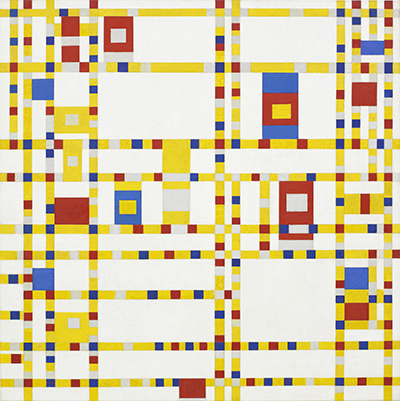Broadway Boogie Woogie represents Mondrian's final major move in his life - in 1940 to New York City.
Upon his arrival in this fascinating city, the artist became passionate about the musical form of Boogie Woogie, a piano dominant form of American blues. It is a complex abstract art work capturing his new home, the city of New York. It focuses on the city from a top-down birdseye view. The repetition of yellow squares is to represent the city's iconic taxis, with light grey used to fill in the rest of the lines to produce the roads. This differs from his long black lines used in earlier abstract compositions.
An invitation from American artist Harry Holtzman led Piet to move to the United States and despite his considerable age at this point, Mondrian never ceased to find enthuasism for new influences, whether artistic or otherwise. Mondrian's love of the vibrancy and energy of this city was something he aimed to represent in this very painting, hence a busier composition than many of his previous abstract work. Further excitement found in New York was the momentum being found here for modern art, it was becoming the capital of the world for all new art forms. To be in the middle of that after moving around the world during his career encouraged Piet of his own legacy.
This highly significant piece, probably Mondrian's most important, was the completed painting from his distinguished career. Victory Boogie Woogie followed on soon afterwards, but was never finished. Broadway Boogie Woogie was completed in 1943, having been started a year earlier. Despite the relative simplicity of his late paintings, Mondrian would still take long periods of time to complete each one from his New York studio.
The original artwork is now on display at the Museum of Modern Art, suitably in New York. It was donated anonymously and would now command an exceptional price were it ever to go up for sale. Whilst Composition in Red, Blue, and Yellow captures the earlier abstract work of Mondrian, so Boradway Boogie Woogie marks the pinnacle of his development in later life. MoMA remains one of the most significant modern art galleries in the world and so it is essential that they hold some of the influential artist's work within their collection. Those fortunate enough to visit the fine establishment will be presented with an extraordinary display of 19th and 20th century art with many of the biggest names included, such as Paul Cézanne, Max Ernst, Frida Kahlo and Rene Magritte.




